Brid Beeler moved to Saudi Arabia in 1989 and stayed for a decade. Her career then led her to live and work in Yemen and Oman and work for some of the world’s top travel companies. She currently heads
Brid Beeler Travel Ltd and travels in and out of the region regularly. This is her second post in a series of stories about her experiences in Saudi Arabia.
Bedouin encampment - Hijaz Harb, 1999
Arab headdress in context
I have always been fascinated by headdresses and nowhere else in the world are more varieties worn by both men and women, than in the Arabian Peninsula. Each region has its own distinctive style of headdress signalling its identity and fashion.
In their most basic form, head coverings are worn to protect from the sun and rain, for warmth in colder climes or to cover the face and protect the eyes in hot desert regions. Head coverings have been used throughout the centuries as a sign of respect when entering a house of worship, as is still the case in many modern societies. The headdress can also be a form of embellishment elevating one’s attire to another level, whether it is a day at the races or the bride’s tiara and veil.
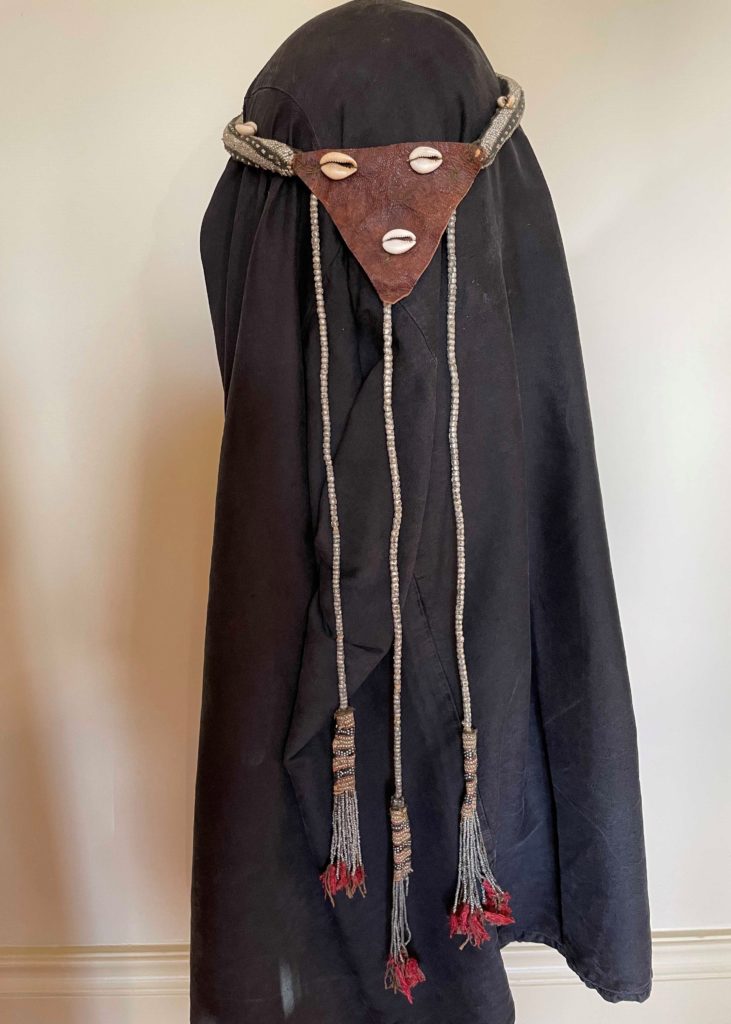
‘Usabah Headdress of the Arabian Peninsula
Among the desert-dwelling tribes of the Arabian Peninsula, head coverings played an even more practical role in the lives of women. In an arid hot desert environment, women tended the sheep, reared the children, gathered the fuel, cooked, broke camp and pitched the tent in new green pastures for their flock. In this stark, monotone environment, colour along with the embellishment of clothing and headdress using beads, cowrie shells and mother of pearl became of primary importance. Leather skins from the sheep are cured and worked into clothing and sandals for both men and women, along with women’s head circlets known as ‘usabah.
The ‘usabah was woven by the women of several Bedouin tribes and generally date to before 1930. It sits atop the various head coverings that may include the
burgu
Burgu’: (Arabic: burqa’: mask, pl. barāqi’), a generic name given to one of many forms of face veils or masks, known as (niqāb). Stiffer versions made of indigo
Indigo: (Latin: Indigo – India, synonym: nil
Nīl: (Latin: indigo), Arabised term for Indigo, a natural dye belonging to the ‘Indigofera Tinctoria’ species of plants that have been cultivated in East Asia, Egypt, India, and Peru since antiquity. According to Pliny the Elder, it was named after India as it was the source of the dye.), a natural dye belonging to the ‘Indigofera Tinctoria’ species of plants that has been cultivated in East Asia, Egypt, India, and Peru since antiquity. According to Pliny the Elder, it was named after India as it was the source of the dye. -dyed cotton, are known as (batūlah) in Oman and Qatar. The (qāf) turns to (ga) in many Arab dialects.’ (veil)
shaylah
Shaylah: (Colloquial Gulf Arabic), a length of fabric used as shawl, head cover or veil. Also known as (wigāyah) or (milfa’), generally made from sheer fabrics such as tulle (tūr), cotton gauze (wasmah
Wasmah: (Arabic: woad), is derived from the woad herb (wasmah) used to dye the cotton gauze black. It is mainly used for headcovers or veils and overgarments in most of the Arab gulf region.) (nidwah) or (Nīl), or silk chiffon (sarī). (headscarf)
gargush
Gargūsh: (Arabic: Qarqūsh), a hood-shaped coif traditionally worn by women of the Jewish community in Yemen. In this case, the name is a variant of the original Arabic word in the local Yemeni dialect.
(bonnet style) or
bukhnuq
Bukhnuq: (Arabic: khanaq: to choke, Pl. bakhānq, bakhānk), a form of veil serves as a (hijāb) used by young girls and women, to cover the head, neck, and upper body, the sides of which are pinned, or sewn, under the chin. Colloquially, the letter (qāf) is pronounced (ga) thus the term is rendered (bukhnug). a form of
hijab
Ḥijab: (Arabic: to cover or conceal, pl: aḥjibah), refers to any article of dress or otherwise, that serves to conceal. In colloquial Egyptian, refers to a large diamond-shaped motif on the torso of (tūr_bi_tallī) wedding dress, or dance robe. Also applied to large central medallion on shawls and scarves. where the sides are pinned or sewn under the chin and covers both the head and shoulders.

The ‘Usabah of the Hijaz
On a camping trip in the late 1990s, we had driven through much of the Harrats (the lava fields in the Hijaz) when we came upon a traditional Beit al Shaar, the black goat-hair tent of the Bedouin. It was rare to encounter traditional Bedouin still living the life of their ancestors, migrating to green pastures as needed for their flocks. We were in the domain of the Harb, a powerful tribe to be reckoned with, originally from Khawlan in Yemen and who are of the Qahtani branch of Arab lineage. Their women were known to go into battle to assist the injured and bring ammunition to the tribe. Such was their formidability that their rivals knew all too well that it was unwise to attack the women of the Harb.
This reputation for ferocity aside, the tribe insisted we join them for gahwa, and chai and dates followed. The women’s section of the tent was separated from the men’s area and the women and children wanted me to join them. Endless giggles and shrieks of delight ensued with children running around and sneaking up to touch my blond hair. Colourful dresses appeared from a metal trunk along with what looked like a man’s ‘iqal. It was a woman’s ‘usabah. The workmanship was meticulous. A circular leather band with tiny silver beads which were worked into the leather in perfect symmetrical geometric designs. Several beaded tassels hung down the back. It was a beautiful piece, although it showed the years of wear. I discovered that these were woven by the women and girls in olden times. They were worn for celebrations like the Eid al Adha and Eid al Fitr holidays, along with wedding celebrations when women gather to sing and dance or any occasion calling for a celebration. It was an old piece, dating back to the foundation of the Kingdom in 1932 according to one of the women. This was the first time I had ever seen one.
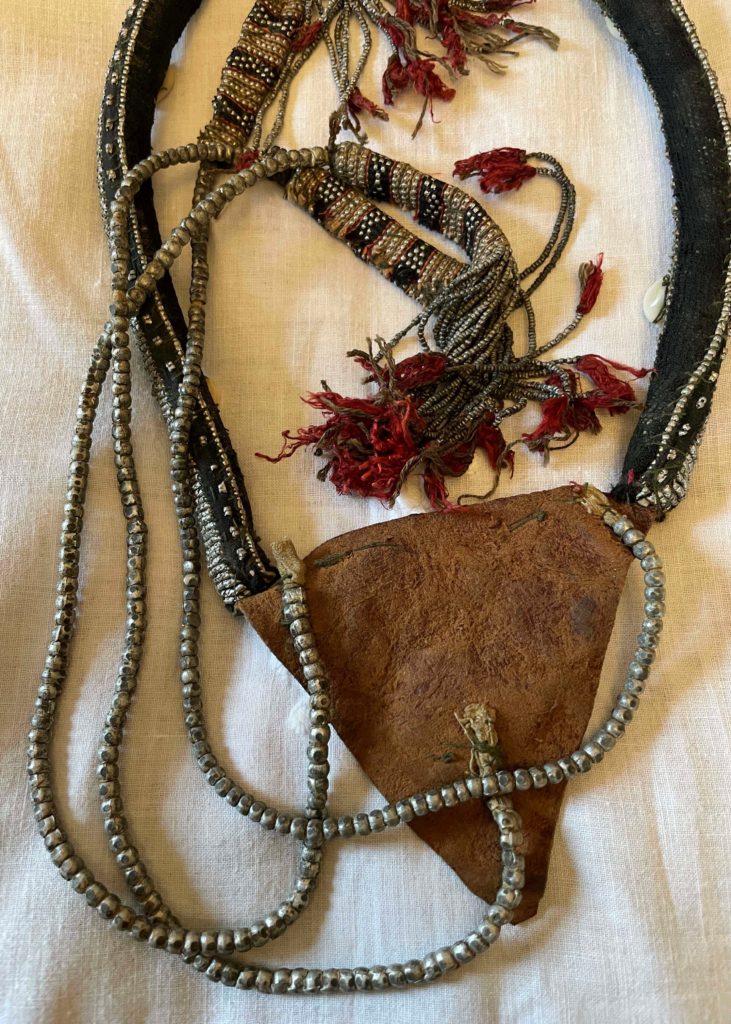
Acquiring my ‘Usabah
Back in Saudi Arabia on a trip in the early 2000s, I flew from Riyadh to Taif but my luggage did not make it. The Saudi driver meeting me was more than accommodating, and we had to wait for the Souq to open after Al Asr prayer so I could purchase some appropriate clothing for the next few days in the desert. As I walked up and down the pavement peering in shop windows, my interest was piqued when I saw an antique shop. I could not pass up the opportunity to take a quick look just in case I might spot something of interest. When the doors opened, the henna-bearded Saudi owner invited me in and there among the jumble of copper cooking pots, brass trays, coffee pots and rugs was a splendid ‘usabah! The shopkeeper told me that it was from the Bani Salim tribe, one of the main sub-sections of the Harb. Needless to say, I bought it immediately and I still thank the airline for losing my luggage that day!
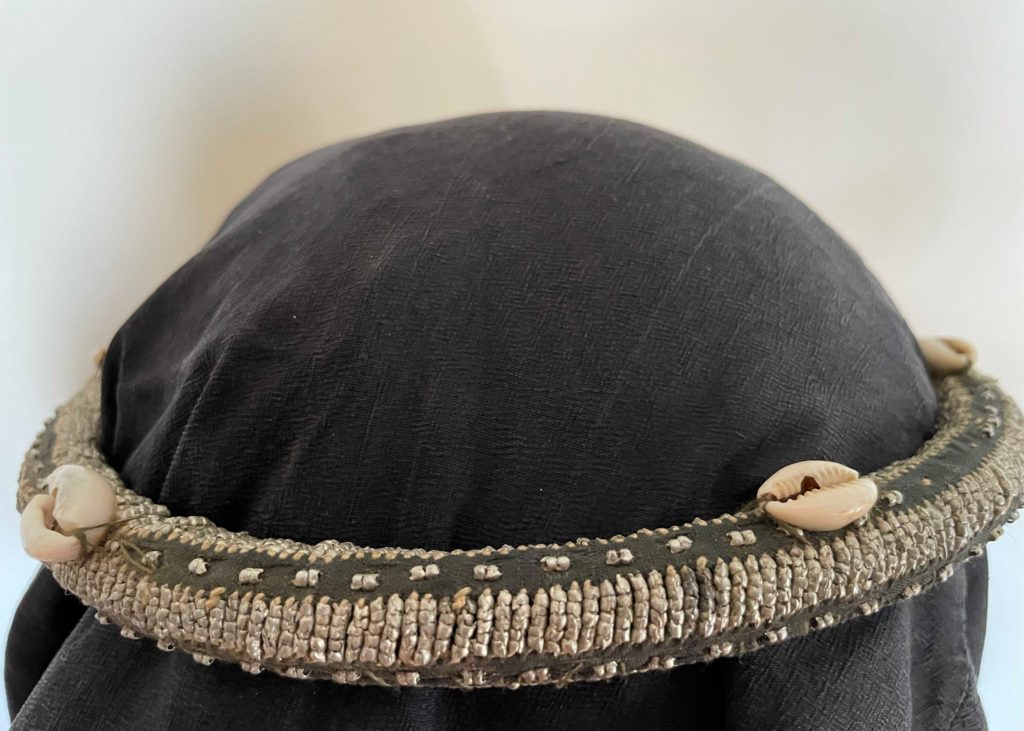
‘Usabah description
The purpose of the ‘usabah was to hold the other head coverings in place as it sat atop the outer layering of head attire. Most have a main circlet with a core of packed wool, wrapped tightly with leather and/or wool cloth, then decorated with tiny silver beads, glass beads or even buttons. Cowrie shells are sometimes used as additional decoration, as shown on my ‘usabah in the photographs. Most have long beaded pendants, hanging down the back of the piece to varying decorative lengths. Coloured woollen and beaded tassels, often demonstrating quite delicate workmanship finish off the end of the pendants.
The circlet of my ‘usabah measures 18.5 cm front to back and 17 cm side to side, with the diameter of the circlet band being 1.6 cm. In the back of the piece is a triangular piece of leather that connects the two ends of the circlet band and to which the three beaded tassel pendants attach. Five cowrie shells are equally spaced around the circlet, and three cowrie shells decorate the otherwise plain leather triangle. The circlet band itself is covered in black wool cloth and intricately decorated with tiny silver beads in addition to the cowrie shells. The pendant cords hang to slightly different lengths, the longest being 51 cm. The round lead alloy beads on the pendants are of cruder workmanship than the tiny silver beads found elsewhere on the piece. The base (head) of each of the three wool tassels is wrapped in naturally dyed wool cloth and covered with tiny silver beads worked into the cloth forming an intricate design. Very small lead beads are strung on the cords terminating in each tassel skirt of red-dyed wool. The piece is believed to be at least 75 years old.
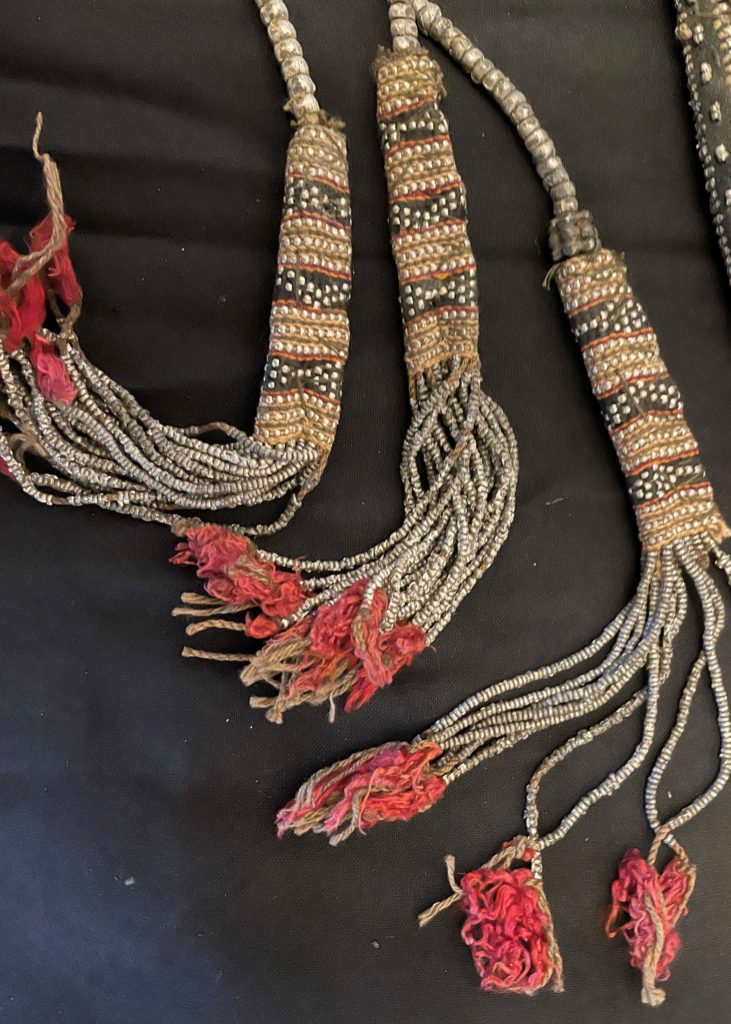
Geographical Distribution of the ‘Usabah
The ‘usabah was worn by several tribes from the Hijaz through the Asir to Yemen, but it was primarily found among the Harb. The Harb reside on the western fringes of the Najd in central Saudi Arabia stretching from Qaseem Province west towards the Hijaz and north of Madinah.
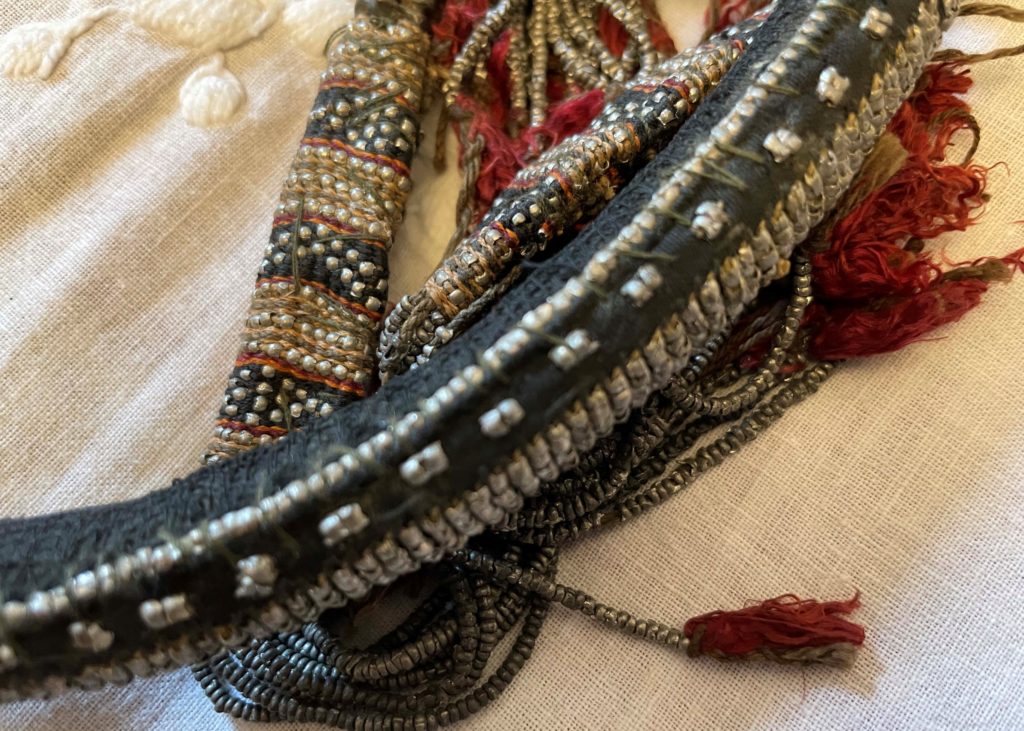
About the Author
In 2015, Brid Beeler managed the Smithsonian Institution’s Sackler Gallery tour in Saudi Arabia, Oman and Qatar, which followed Saudi Arabia’s internationally acclaimed Roads of Arabia exhibit. Brid facilitated the History Channel’s Yemen documentary “Digging for the Truth – The Real Queen of Sheba.” She participated in the multi-level cultural project involving the Smithsonian and the Yemen and US governments resulting in the publication of Caravan Kingdoms Yemen and the Ancient Incense Trade. With Crossing the Line Films, she facilitated logistics and key components for their award-winning documentary on the annual Qashqai migration in Iran, which was aired by National Geographic under the title Last Chance Journeys Iran. Brid also consulted on a UNICEF, World Food Program project advocating for girls’ education in Yemen.
She has presented papers on eco-tourism in the region and was one of only a handful of women selected to speak at the first International Conference on Eco-Tourism in Saudi Arabia. Her other speaking engagements have included The Ethnic Silver Jewelry of the Arabian Peninsula at the Chester Beatty Library in Dublin Castle. She currently contributes monthly to
aramcoexpats.com. Her collecting, which began in the souqs of Riyadh before extending to Yemen, Oman and further afield, focuses on old silver jewellery, semi-precious stones, beadwork, and textiles from the Arabian Peninsula
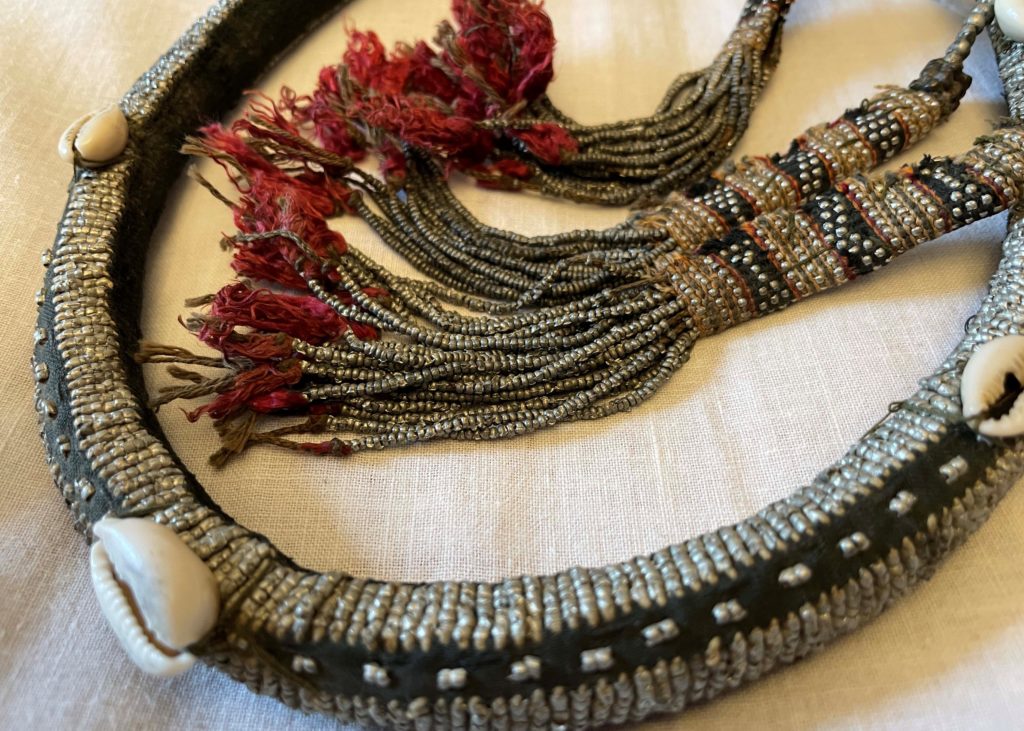
Further Reading
- Heather Colyer Ross. The Art of Arabian Costume, A Saudi Arabian Profile. Third Edition, 1989
- John Topham and others. Traditional Crafts of Saudi Arabia, 1982
- Traditional Costumes of Saudi Arabia – The Mansoojat Foundation Collection, 2021
- Bukhnug
Bukhnug: (Arabic: khanaq: to choke, pl. bakhānq, bakhānk), a form of veil (Niqāb), serves as a (hijāb) used by young girls and women, to cover the head, neck, and upper body, the sides of which are pinned, or sewn, under the chin. Colloquially, the letter (qāf) is pronounced (ga). - A Chance encounter. The first post in this series by Brid Beeler
*Copyright to all images belongs to Brid Beeler unless otherwise indicated. Reproduced here with permission. 










